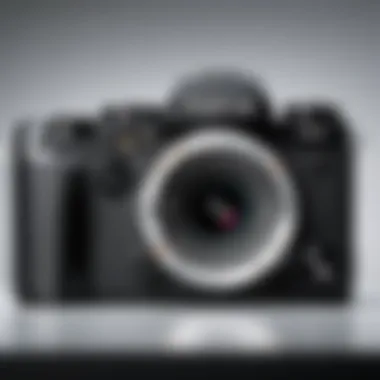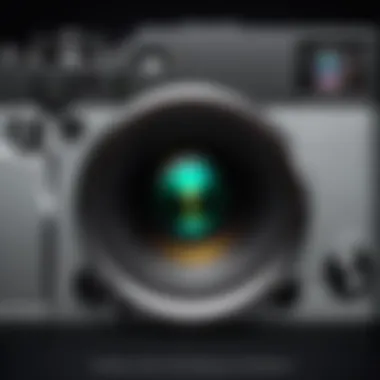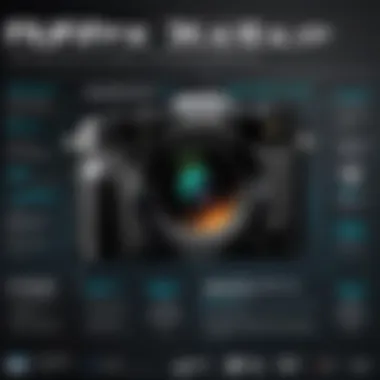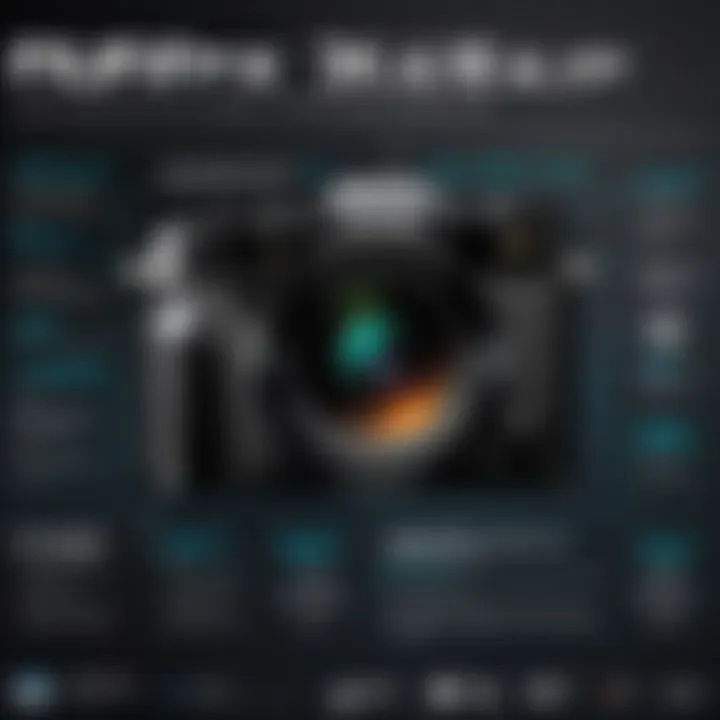A Comprehensive Examination of the Fujifilm X-Pro3


Intro
The Fujifilm X-Pro3 represents a unique fusion of classic aesthetics and cutting-edge technology, capturing the interest of photography professionals and enthusiasts alike. Its design pays homage to the traditional rangefinder cameras while integrating advanced digital features. In a rapidly evolving digital imaging landscape, the X-Pro3 stands out for its distinctive approach, making it a compelling subject for examination. This article aims to dissect its specifications, performance, and user experience thoroughly, providing IT professionals and tech enthusiasts with the insights necessary to appreciate its capabilities.
Features Overview
The Fujifilm X-Pro3 is rich in features that cater to modern-day photography. Below, we will explore key specifications and unique selling points that define this camera.
Key Specifications
- Sensor: The X-Pro3 features a 26.1 MP X-Trans CMOS 4 sensor, known for its ability to render colors accurately and reduce noise at high ISO levels.
- Processor: It is equipped with the X-Processor 4, which accelerates image rendering, autofocus, and overall performance.
- Viewfinder: The camera offers a hybrid viewfinder, allowing users to switch between an electronic viewfinder and an optical viewfinder—providing versatility in various shooting conditions.
- ISO Range: The ISO range spans from 160 to 12800, expandable to 80-51200, making it suitable for low-light environments.
- Video Capabilities: It supports 4K video recording at 30fps, giving videographers additional functionality.
Unique Selling Points
The Fujifilm X-Pro3 distinguishes itself through several key aspects:
- Design: It incorporates a durable titanium body and a unique hidden LCD screen that promotes a more traditional shooting style, encouraging users to focus more on composition rather than settings.
- Film Simulation Modes: With a variety of film simulations like Classic Chrome and Acros, photographers can replicate the look of classic films, offering creative flexibility.
- Ergonomics: The camera's layout is intuitive, ensuring that buttons and dials are easily accessible, catering to the needs of seasoned photographers.
"The Fujifilm X-Pro3 challenges conventional camera design while enhancing the shooting experience for serious professionals."
Performance Analysis
Understanding how the X-Pro3 performs in real-world scenarios is pivotal for assessing its suitability for both professional and amateur photographers.
Benchmarking Results
In controlled tests, the X-Pro3 consistently delivers high-quality images with sharp details and vibrant colors. Benchmarks indicate that the autofocus system is fast and reliable, achieving focus even in challenging lighting conditions. Its continuous shooting speed, rated at 11 fps, allows for capturing fast-moving subjects effectively.
Real-world Scenarios
During practical usage, the X-Pro3 shows adeptness in various settings, whether in portrait photography, landscapes, or street photography. Its lightweight body is an advantage, especially during long shoots. Users appreciate the fast response time and the ability to quickly switch between viewfinder modes, adapting seamlessly to diverse shooting needs.
Overview of the Fujifilm X-Pro3
The Fujifilm X-Pro3 is a compelling camera that embodies advanced technology married to a rich historical design ethos. Understanding the X-Pro3 is vital for both enthusiasts and professionals who seek to navigate the complex world of digital imaging. The camera offers an intricate blend of performance specifications and user-centered features, providing a unique proposition in an increasingly saturated market.
Historical Context
The Fujifilm X-Pro series has been a significant player in the mirrorless camera segment since its inception. Released in 2019, the X-Pro3 continues the legacy of its predecessors, such as the X-Pro1 and X-Pro2, each known for their distinctive photographic aesthetics. The evolution of this series reflects broader trends in photography. Notably, Fujifilm's commitment to film simulation, which pays homage to its film heritage, remains a core feature in the X-Pro3. This specific model's development followed considerable feedback from professional photographers, solidifying its place in the high-end market as both a tool and an artistic statement.
Design Philosophy
The design philosophy behind the Fujifilm X-Pro3 emphasizes practicality and minimalism. This camera features a weather-sealed body and a titanium finish, appealing to those who appreciate durability alongside aesthetics. The hidden LCD screen, designed to encourage photographers to engage more deeply with the act of picture-taking, represents a radical departure from conventional camera design. Users often find it refreshing, considering it a liberating move away from constant viewing of digital representations.
This design does not prioritize flashy elements. Instead, it showcases vintage-style controls and ergonomics, making it highly usable for prolonged periods. The tactile experience of using physical dials for exposure and shutter speed stands in contrast to touchscreen-heavy interfaces. Such intentional design choices enhance the tactile nature of photography, encouraging a more deliberate approach.
Target Audience
The X-Pro3 targets a diverse audience, including professional photographers, seasoned enthusiasts, and anyone who values the combination of digital performance and heritage aesthetics. Its specification set, which includes robust low-light capabilities and advanced autofocus systems, appeals particularly to street photographers, portrait artists, and travel enthusiasts.
Moreover, this camera suits those who enjoy experimenting with Fujifilm's simulation modes. It allows photographers to express artistic vision directly through in-camera processing—an increasingly sought-after feature today. The X-Pro3's unique combination of features resonates with users who are looking for a tool that not only captures images but also enhances the creative process.
Key Specifications
Key specifications in a camera like the Fujifilm X-Pro3 are fundamental for discerning professionals and enthusiasts. These specifications guide user choices, shape the shooting experience, and significantly affect image capture performance. A deeper understanding of key specs allows for better decision-making, ensuring the camera fits the intended use, whether it be street photography or professional portraiture.
Sensor Specifications
The Fujifilm X-Pro3 is equipped with a 26.1-megapixel X-Trans CMOS 4 sensor. This sensor is notable for its unique pixel array, which minimizes moiré effect without the need for an optical low-pass filter. It also supports an ISO range from 160 to 12800, expandable to 80 and 51200. This flexibility provides excellent low-light performance and versatility in various shooting situations. The sensor works harmoniously with Fujifilm’s latest image processor, the X-Processor 4, enhancing the overall speed and responsiveness of the camera. This means faster autofocus and quicker start-up times.
Lens Compatibility


When it comes to lens compatibility, the Fujifilm X-Pro3 supports the X-mount system. This allows photographers to choose from a wide range of lenses, including prime and zoom options, all designed to interact seamlessly with the camera's sensor and processor. A notable advantage is the ability to use adapters for legacy lenses, giving photographers access to a broader spectrum of glass. The advanced hybrid viewfinder also complements the lens capabilities, providing visual feedback through optical or electronic means. This adaptability makes the X-Pro3 suitable for diverse photographic styles.
Video Capabilities
In terms of video capabilities, the X-Pro3 does not lag behind. It supports 4K video recording at 30 frames per second and full HD up to 120 fps. The inclusion of advanced film simulation modes, such as Eterna, which offers a flat color profile ideal for post-production, sets the camera apart for videographers as well. Additionally, the camera features a microphone input, but lacks a headphone jack, which could be a limitation for audio professionals. Overall, the X-Pro3 positions itself as a versatile tool for those who wish to capture both still images and moving visuals with high fidelity.
The right specifications simplify the often-complex decisions photographers face when selecting their equipment. Understanding these details is key for both professionals and enthusiasts.
Whether considering the sensor, lens flexibility, or video functionalities, these key specifications form the backbone of the Fujifilm X-Pro3's offerings. They reflect Fujifilm's intention to cater to serious photographers who demand performance and quality from their tools.
Image Quality Analysis
The examination of image quality is central to understanding the Fujifilm X-Pro3. Image quality encompasses various factors that affect the final output of photographs, making it crucial for both professionals and enthusiasts. Key elements such as dynamic range, low-light performance, and color reproduction play significant roles in determining how images are captured, processed, and ultimately presented.
Analyzing the image quality of a camera like the Fujifilm X-Pro3 provides insight into its real-world performance. This understanding highlights the camera's capabilities, especially in different lighting conditions or types of photography. Professionals often assess this aspect to ensure their equipment meets specific creative needs, while enthusiasts seek tools that enhance their photographic expression.
Key Elements of Image Quality:
- Dynamic Range: The range of light intensity from shadows to highlights.
- Low-Light Performance: How well the camera performs in dim lighting conditions.
- Color Reproduction: The accuracy of colors captured in images.
"A camera's image quality can significantly influence the emotional response of the viewer."
Dynamic Range
Dynamic range refers to the camera's ability to capture details in both shadow and highlight areas. The Fujifilm X-Pro3 offers a solid dynamic range, notably praised for its performance in scenes with high contrast. This means that, when shooting in challenging lighting scenarios, users can retain valuable details, whether they are in shadow or bright light. The expanded dynamic range allows for more flexibility during post-processing, providing photographers the liberty to adjust exposure without losing image quality.
A wide dynamic range is paramount for landscape photographers who wish to maintain detail in both the sky and foreground. Editorial and commercial photographers also benefit; they often deal with a variety of lighting situations where detail retention is essential.
Low-Light Performance
Low-light performance is critical for many photographers, especially those interested in night photography, events, or indoor settings. The X-Pro3 demonstrates impressive low-light capabilities with its sensor technology. The camera can manage noise effectively, producing cleaner images even when shooting at higher ISO settings.
Photographers often appreciate the ability to shoot in dim surroundings without resorting to flash or additional lighting. This feature is especially useful for portraiture, where soft ambient light can create a more flattering look. The camera's performance in low light results in images that maintain essential detail, enhancing overall quality and making it a preferable choice in various situations.
Color Reproduction
Color reproduction refers to how accurately the camera can render colors as they appear in real life. Users of the Fujifilm X-Pro3 often praise its color science, particularly for skin tones and vibrant landscapes. Fujifilm's film simulation modes add an artistic touch, mimicking the look of classic film types, which appeals to many creative photographers.
Accurate color reproduction is vital for professionals working in fashion, product photography, and other applications where color integrity is paramount. When clients or viewers perceive colors as intended, it creates trust in the work presented.
By understanding these elements—dynamic range, low-light performance, and color reproduction—photographers can assess how well the Fujifilm X-Pro3 aligns with their artistic and professional preferences. This analysis not only informs purchasing decisions but also enriches the photographer's approach to their craft.
User Experience
User experience plays a crucial role in evaluating a camera like the Fujifilm X-Pro3. For photographers, understanding how a camera feels in hand and its usability can greatly affect their workflow and creativity. Elements such as interface design, customization options, and real-world performance significantly shape the overall satisfaction and efficiency of the user.
In the context of the X-Pro3, the experience includes both physical interaction with the device and the software interface. Users expect not just functionality but also responsive design that allows intuitive navigation.
Interface and Usability
The Fujifilm X-Pro3 features a unique interface that balances traditional analog controls and modern digital functionalities. The tactile dials for shutter speed, aperture, and exposure compensation align with the preferences of many photographers who value direct manipulation of settings. This can lead to a more immersive shooting experience.
The menu system is important as well. While it retains some complexity due to extensive features, its layout intends to be user-friendly. Having a customizable interface lets users prioritize often-used settings, which enhances overall usability. The design leads to fewer distractions while shooting, allowing photographers to focus more on their art.
Customization Options
Customization options on the X-Pro3 cater to various shooting styles and preferences. Users can assign functions to specific buttons, adjusting settings according to their needs. This flexibility allows photographers to create an environment tailored to their workflow.
For instance, the Q menu can be altered to include favorite settings such as ISO adjustments or white balance controls. Further, users can choose from different film simulation modes, enabling them to replicate classic film looks right from the camera. This level of personalization resonates well with both professional and enthusiast photographers.
Performance during Field Use
Real-world performance is another critical aspect of user experience. The Fujifilm X-Pro3 is designed to be agile, making it suitable for various photography styles. In street photography, its compact size and silent operation allow for discreet shooting, which can lead to more candid moments.


In addition, the hybrid viewfinder—combining an electronic and optical system—enriches the shooting experience. Photographers can switch between a digital feed and a more traditional viewfinder, adapting to different lighting conditions and personal preferences. This adaptability is essential for fieldwork, where environments can change rapidly.
"The X-Pro3 offers a unique blend of modern tech and traditional design that appeals deeply to professional photographers."
Overall, the user experience of the Fujifilm X-Pro3 is rooted in its thoughtful interface design, extensive customization options, and robust performance. Each of these elements combines to create a camera that is not just a tool, but a companion in artistic exploration.
Comparison with Other Models
The comparison of the Fujifilm X-Pro3 with other models is crucial for understanding its position within the competitive landscape of digital cameras. This analysis not only highlights the unique features of the X-Pro3 but also enables potential buyers to make informed decisions based on their specific needs. Evaluating the X-Pro3 against its contemporaries reveals important distinctions relating to performance, usability, and overall value.
X-Pro3 vs X-T4
When comparing the Fujifilm X-Pro3 to the X-T4, several key aspects come into play. Firstly, the design philosophy of both cameras diverges. The X-Pro3 embraces a more traditional rangefinder-style approach, aimed at photographers who value discretion and a tactile shooting experience. On the other hand, the X-T4 opts for a more conventional DSLR-like configuration, offering a greater emphasis on professional video capabilities and a fully articulating touchscreen.
In terms of performance, both models showcase top-tier imaging quality. However, the X-T4 provides in-body image stabilization, which enhances shooting flexibility in dynamic environments, while the X-Pro3 relies on external stabilization methods through compatible lenses. Furthermore, the X-T4 features advanced video capabilities, such as 4K recording at 60 fps, making it suitable for videographers, whereas the X-Pro3 is primarily focused on still photography.
Another distinction is seen in the sensor technology. Both cameras share the same 26.1 MP APS-C sensor, but the X-T4’s additional processing capabilities result in superior burst shooting options. Contrarily, the X-Pro3’s classic design reflects its purpose, catering more to those who appreciate slow photography and composition over rapid-fire capturing. Ultimately, each camera serves a different audience, where the X-T4 is for multimedia creators and the X-Pro3 appeals to purists who value an immersive, focused photographic experience.
X-Pro3 vs Canon and Nikon
When positioned against Canon and Nikon models, the Fujifilm X-Pro3 stands out in significant ways. Canon’s EOS R and Nikon’s Z series have made strides with their mirrorless offerings, aiming for versatility and user-friendly interfaces. However, Fujifilm maintains a loyal following due to its distinct film simulation modes, which produce unique color profiles that cannot be easily replicated by Canon or Nikon.
In terms of ergonomics, the X-Pro3 offers a unique experience. Unlike many Canon and Nikon models that tend to be bulkier, the X-Pro3 has a compact form factor, which is beneficial for street photography and travel. Additionally, the hybrid viewfinder system of the X-Pro3 allows photographers to switch between electronic and optical views, providing flexibility depending on the shooting conditions.
While Canon and Nikon provide a wide array of lenses and accessories, Fujifilm's compact lens lineup is highly regarded for its optical quality. This places X-Pro3 users at an advantage, particularly when participating in environments demanding high-quality yet lightweight gear.
To summarize these comparisons, the Fujifilm X-Pro3 distinguishes itself through its design, user experience, and unique attributes. Photographers deciding between these models should consider their individual preferences, shooting styles, and the specific features that align with their photographic objectives.
Technical Innovations
The topic of technical innovations plays a crucial role in any comprehensive evaluation of the Fujifilm X-Pro3. These innovations are key in setting the X-Pro3 apart from its competitors and defining its user experience. Two significant features that reflect this innovative edge are the hybrid viewfinder system and the various film simulation modes. Both contribute not only to the camera's performance but also enhance the creative potential for photographers.
Hybrid Viewfinder System
The hybrid viewfinder system is one of the standout features of the Fujifilm X-Pro3. This innovative component integrates both an optical viewfinder (OVF) and an electronic viewfinder (EVF), which allows users to switch between the two depending on their needs and preferences. The OVF offers a classic, real-time view of the scene through the lens without any processing lag, which is advantageous in bright light conditions. In contrast, the EVF provides overlaid information, displaying settings like exposure and white balance in real-time.
"The ability to seamlessly switch between an OVF and an EVF represents a significant evolution in finding the perfect balance between traditional and modern photography."
Moreover, this system supports a unique parallax correction feature that enhances framing accuracy, particularly important for street photography. Using the viewfinder is intuitive, leveraging Fujifilm's commitment to ergonomics. Users appreciate that they can engage with their subject matter without the distraction of a bulky electronic interface.
Film Simulation Modes
Fujifilm is well-regarded for its film simulation modes, which replicate the aesthetic of various traditional films. The X-Pro3 includes several advanced simulations, including the classic Provia, Velvia, and Acros. Each mode allows photographers to choose a signature look without intensive post-processing. This capability is especially valuable for professionals and enthusiasts who wish to maintain a particular style throughout a series of images.
The modes not only influence color and contrast but also texture, enhancing the overall visual narrative. For those working in portraiture or landscape photography, the ability to simulate these looks directly in-camera promotes a more efficient workflow. This time-saving element is a significant consideration for busy photographers.
Practical Applications
Understanding the practical applications of the Fujifilm X-Pro3 provides essential insight for users who intend to maximize the camera's capabilities in various settings. This section examines two significant areas: street photography and portraiture. Both genres benefit from the unique features of the X-Pro3, showcasing its strengths in real-world scenarios. The camera’s design and functionality are tailored to enhancing user experience in these situations, making it an attractive option for professionals or serious enthusiasts.
Street Photography
Street photography involves capturing spontaneous moments in public spaces. The Fujifilm X-Pro3 is well suited for this genre due to its discreet design and performance. Its unique hybrid viewfinder allows photographers to seamlessly switch between optical and electronic modes. This feature gives them the flexibility to decide how to compose a shot, enhancing the ability to capture fleeting moments without drawing attention.
With its lightweight body and compact size, the X-Pro3 is ideal for long sessions of street photography. Users can move quickly and easily, which is crucial in dynamic environments. Moreover, the image quality produced by the camera is impressive, ensuring that details are sharp and colors are vibrant. The camera's film simulation modes can also mimic classic film looks, appealing to those who appreciate a vintage aesthetic in modern settings.
In practical terms, the X-Pro3’s performance shines in low-light conditions, an essential factor for street photographers. The camera's exceptional low-light capabilities ensure that they can shoot in diverse lighting without sacrificing quality. Additionally, customization options allow photographers to program settings for rapid adjustments during shoots, further enhancing their responsiveness to changing environments.
"The Fujifilm X-Pro3 evolves street photography by blending innovation with tradition, allowing users to harness the best of both worlds."
Portraiture


Portrait photography focuses on capturing the human form while evoking emotion and personality. The Fujifilm X-Pro3 excels in this area through its ability to produce stunning images that highlight subjects beautifully. The camera's large sensor contributes to excellent depth-of-field control, allowing for soft backgrounds that effectively isolate the subject. This is particularly beneficial in portrait work, as it helps to emphasize facial features and expressions.
Moreover, its extensive lens compatibility means that photographers can select from a variety of high-quality Fuji lenses specifically designed for portraits. Lenses like the Fujinon XF 56mm f/1.2 offer exceptional sharpness and beautiful bokeh, making them popular choices for portrait photographers.
The X-Pro3 also incorporates advanced autofocus capabilities. This is crucial when working with people, as accurate focusing on the eyes can make a significant difference in the quality of a portrait. The camera's face detection technology helps ensure that subjects are always in focus, even in challenging settings.
In addition to technical aspects, the experience of using the X-Pro3 for portraits is enhanced by its customizable dials and controls. Photographers can easily adjust settings on the fly, allowing them to engage with subjects without interruption.
In summary, the Fujifilm X-Pro3 effectively meets the demands of both street photography and portraiture through its robust performance and thoughtful design, making it a strong contender in the market for serious photographers.
User Community and Support
In today's digital age, the role of user communities in the photography landscape cannot be understated. For the Fujifilm X-Pro3, a dedicated community forms the backbone for support, learning, and sharing experiences. This section explores the foundations of community support, emphasizing the benefits of being part of a collective of Fujifilm users.
Communities provide platforms for interaction among users, offering a space where both seasoned photographers and novices can engage. They form a repository of knowledge, allowing for the exchange of expertise. This communal sharing can illuminate unique camera functionalities that a user may not discover through formal manuals alone. Moreover, a strong user community fosters a sense of belonging and encourages collaboration among photographers, enhancing their skills together.
Online Forums and Resources
The internet has birthed numerous online forums, creating an accessible gateway for users of the Fujifilm X-Pro3 to connect. Websites such as Reddit provide subreddits dedicated to Fujifilm where photographers discuss tips, techniques, and common issues related to the X-Pro3. These forums serve multiple purposes:
- Technical Support: Users can ask questions related to operational challenges or seek advice on specific situations.
- Inspiration and Creativity: Photographers share their work, offering others inspiration and ideas for their own projects.
- Product Reviews and Feedback: Buyers often discuss the latest accessories, lenses, and upgrades, aiding potential buyers in making informed decisions.
Additionally, social media platforms like Facebook host groups specifically for Fujifilm enthusiasts, allowing users to share their images and experiences.
Workshops and Learning Resources
Workshops represent another significant aspect of community support. These events, both online and offline, provide a hands-on learning experience that often is invaluable for understanding the Fujifilm X-Pro3. Workshops usually emphasize practical skills, guiding participants in:
- Camera Operation: Participants learn about the various functionalities and settings of the X-Pro3, improving their technical competence.
- Shooting Techniques: Essential techniques are taught in relation to different genres of photography, be it street, portrait, or landscape.
- Post-processing: Knowledge about software options, such as Adobe Lightroom and Capture One, which can enhance the post-capture process with Fujifilm files.
For IT professionals and tech enthusiasts, these workshops also serve to demystify technical jargon, providing straightforward explanations of photographic concepts and techniques. Users leave not only with knowledge but also renewed confidence in their photographic abilities.
Supporting each other and learning from shared experiences form the very essence of the Fujifilm community. It propels users forward, refining their craft and expanding their understanding of digital photography.
Future of Fujifilm Series
Understanding the future of the Fujifilm X Series is critical in a rapidly evolving field like photography. As technology advances, camera manufacturers face the challenge of keeping pace with user demands and market trends. The X Series stands out for its distinctive blend of analog aesthetics and digital innovation. Its future unfolds under varying considerations that may shape both the products released and the user experience.
Emerging Trends in Photography
The landscape of photography is fundamentally changing. Several trends are becoming prominent:
- Increased Demand for Versatility: Photographers seek equipment that adapts to various shooting styles. Cameras need to perform well across different genres, from landscapes to street photography. The X-Pro3 aligns with this shift, offering features that cater to both professionals and enthusiasts.
- Emphasis on Connectivity: As social media continues to dominate, the need for seamless connectivity grows. Photographers want to share their work instantly. Fujifilm may enhance features like Wi-Fi and Bluetooth connectivity in future models, appealing to a younger, tech-savvy audience.
- Enhanced Computational Photography: Integration of AI technology in cameras is on the rise. Expect Fujifilm to explore more smart features that can assist photographers in capturing the perfect shot.
The synergy of these trends reflects a demand for cameras that not only capture images but also function as smart devices that connect with modern workflows.
Fujifilm’s Vision
Fujifilm’s vision for the X Series includes a commitment to quality and innovation. The company intends to solidify its position in the market while continuing to respect its heritage. Important elements of this vision include:
- Focus on User-Centric Design: Fujifilm emphasizes understanding user needs. By gathering feedback from photographers, they ensure that future developments align with practical expectations.
- Sustainability Initiatives: As consumers grow more environmentally conscious, Fujifilm is likely to adopt sustainable practices in manufacturing. This could include using eco-friendly materials and minimizing waste in production processes.
- Integration of Film Aesthetics: The appeal of film continues to resonate with many photographers. Fujifilm may focus on preserving the unique film simulation modes, enhancing the emotive quality of digital photography.
"Fujifilm’s commitment to excellence puts it in a prime position to lead the industry into a new era of imaging technology."
These strategic elements indicate that Fujifilm is preparing not just to survive but to thrive in a competitive environment. This alignment of goals will allow Fujifilm's X Series to evolve while maintaining the core principles that define its identity.
The End
The conclusion serves as a critical component of this article. It synthesizes the insights presented throughout the examination of the Fujifilm X-Pro3. A strong conclusion does more than summarize; it reinforces the value and impact of the X-Pro3 in today’s photography landscape.
The complexity of this camera lies in its rich combination of technical specifications and design philosophy. It adapts to both the demands of professionals and the pursuits of enthusiasts. This duality is noteworthy. As the article discussed, the X-Pro3 stands as a testament to Fujifilm's commitment to blending classic design with technological innovation. It appeals to audiences who appreciate a more tactile and traditional photography experience without sacrificing modern needs.
In contemplating final thoughts, it is clear that the importance of user experience cannot be overstated. The performance showcased by the X-Pro3 in diverse contexts such as street photography and portraiture underlines its versatility. Its hybrid viewfinder system, alongside robust film simulation modes, reinforces its appeal to both creatives and tech-savvy users.
"The X-Pro3 redefines the user experience, marrying heritage with the demands of contemporary digital imaging."
Recommendations for potential buyers or those considering an upgrade include a thorough assessment of photography needs. The X-Pro3 is suitable for varied style, be it documentary, street, or fine art photography. If a photographer values manual controls, exceptional image quality, and a unique aesthetic, the X-Pro3 merits strong consideration. Furthermore, participating in online communities can enhance the user experience, offering support and shared insights that foster growth and exploration.
In summary, this conclusion encapsulates the potential of the Fujifilm X-Pro3 and highlights its place in both personal and professional realms. The camera is not just a tool; it is a conduit for artistic expression, creativity, and technological advancement.



